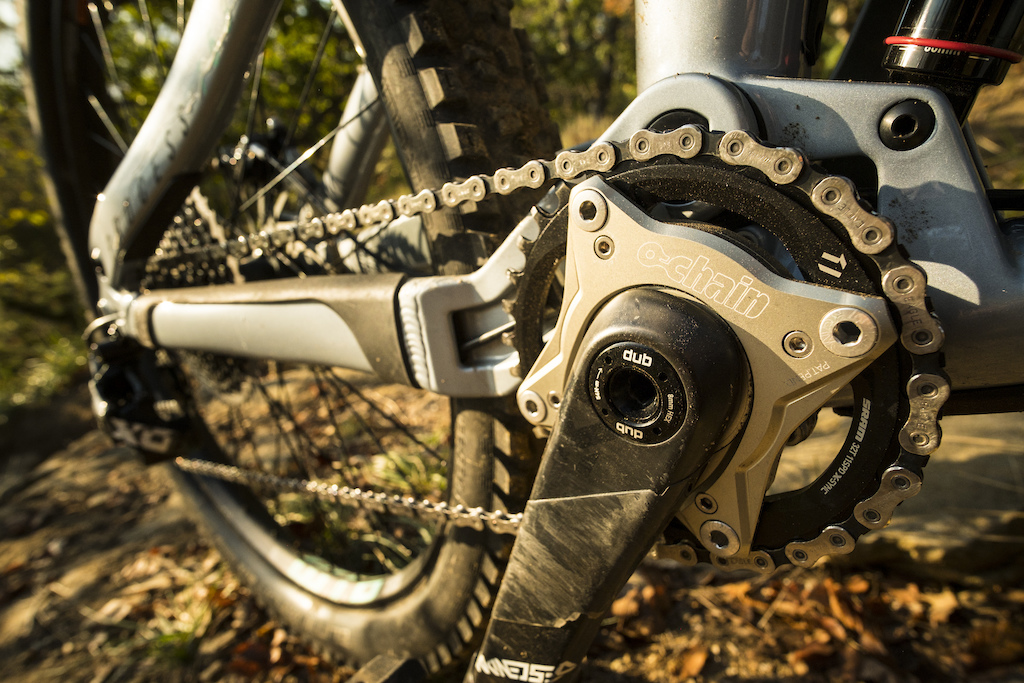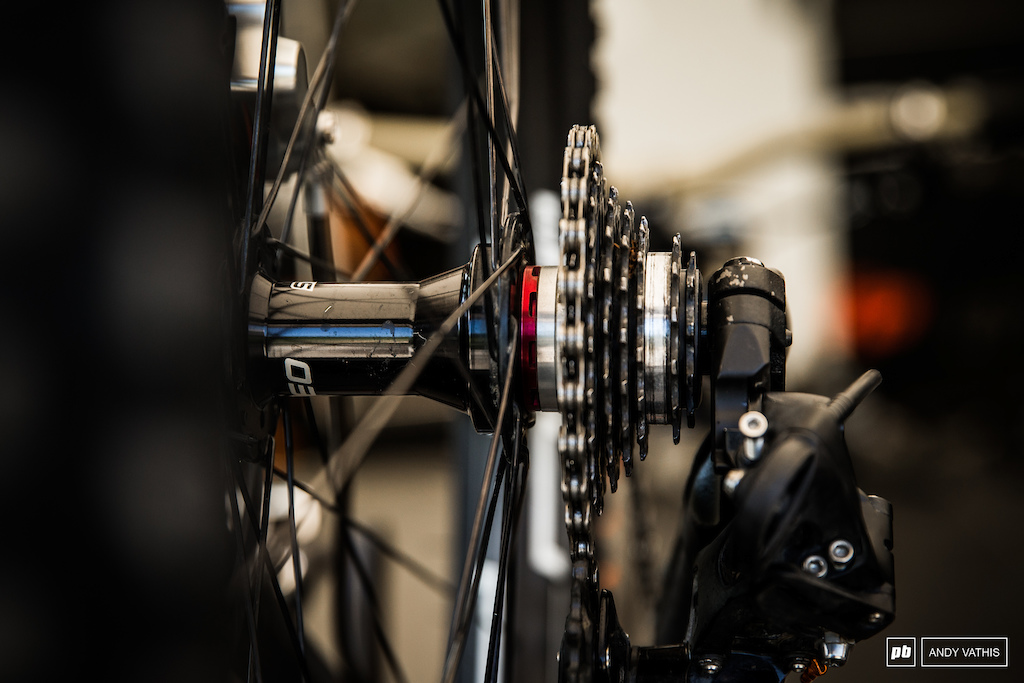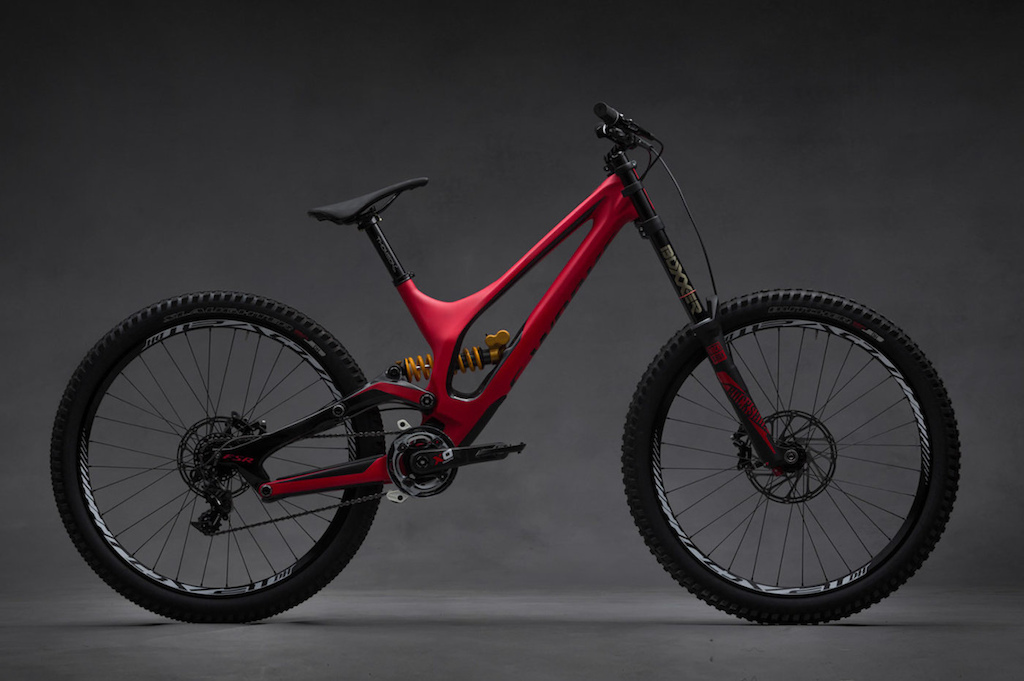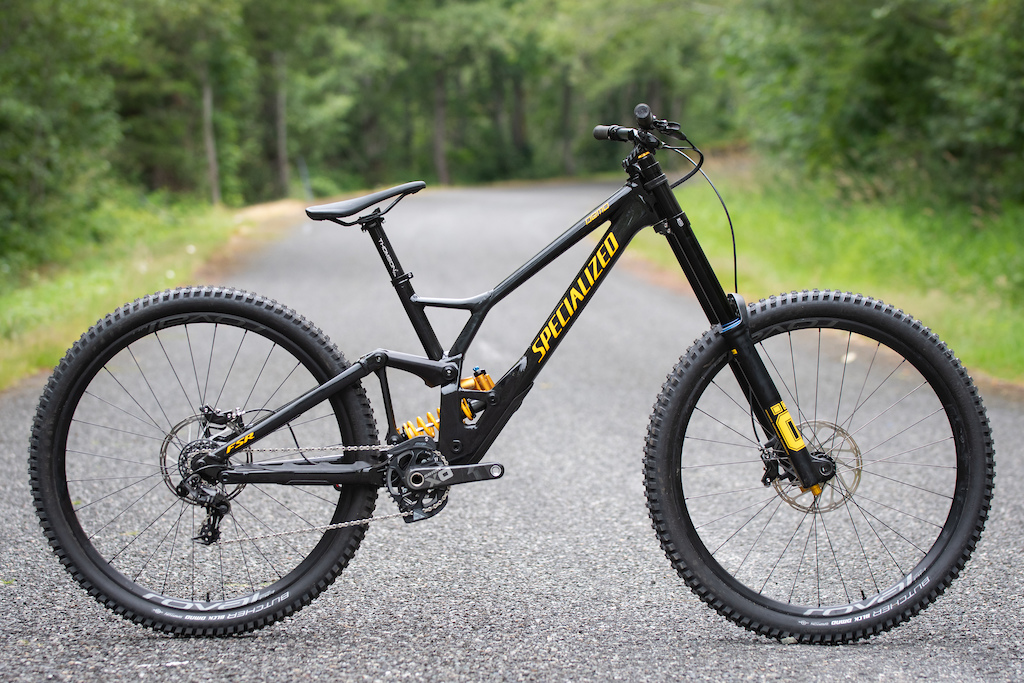Nerding Out: Why You Shouldn't Worry About Pedal Kickback
At World Champs in 2014, Neko Mulally snapped his chain out of the gate but went on to score a career-best 4th place. The following year, Aaron Gwin snapped his chain in Leogang, and he went on to win. After crossing the line, he could be heard saying "The suspension works so much better without a chain."
How can we explain this? It's obvious, right? Pedal kickback.
There are all sorts of devices designed to eliminate pedal kickback, but do we really need them?
In virtually all suspension designs, the rear axle gets further away from the bottom bracket as the suspension compresses - that's because the main pivot is above the bottom bracket. This causes the length of the chain span from the cassette to the chainring to increase, which is known as chain growth. If the suspension is compressed while the rear wheel doesn't rotate, the cranks will be forced to rotate backwards through a certain angle because the cassette moves further away from the chainring. This is pedal kickback.
If the suspension moves through its entire travel without the wheel rotating, the cranks would rotate backwards by an angle that can be as much as twenty degrees or so, depending on the suspension design and the gear selected. Generally, bikes with more rearward axle paths and therefore higher levels of anti-squat will have more chain growth and therefore more pedal kickback.
Hucking
It's often said that pedal kickback leads to harshness, feet being blown off pedals and restricted suspension. But pedal kickback is more of a theoretical calculation than a real-life phenomenon. When riding, the crank doesn't usually rotate back to allow the chain growth; the cassette rotates forwards. As long as the wheel is spinning at a reasonable speed, it's very easy for the cassette and freewheel to rotate clockwise, which allows the suspension to compress without the cranks rotating.
You can see this in the below huck-to-flat video. Here the bikes are going quite slowly and the suspension is compressing pretty fast - quick enough to reach bottom-out - yet the cranks don't rotate backwards. In fact, the chain has enough slack to wave around and sag under its own weight. For the chain to rotate the cranks, it would need to be taut which would make it roughly straight.
There are situations where the wheel may be rotating so slowly and the suspension compresses so quickly that the cassette and freewheel "catch up" with the wheel speed and so cannot rotate any faster, in which case the chain will become taut and apply a backwards torque on the crank. You can feel this if you land a drop to flat while travelling at a very slow speed.
But even in a worst-case scenario - a bike with a lot of chain growth, the suspension compressing at a particularly high speed (five meters per second), and the chain on the smallest sprocket so the wheel has to rotate further to spool out enough chain - pedal kickback is impossible when travelling above about ten miles per hour or sixteen kilometres per hour. Remember that's a worst-case: for most combinations of bike choice, suspension compression speed and gear choice, the minimum speed required to avoid kickback is much slower.
I'm not saying that pedal kickback never happens, but it's what you might call a corner case, a rare combination of circumstances. You certainly can't blame it for repeatedly blowing your feet off the pedals on a rock garden.
Braking
In the opening shot of this video you can see the rear wheel lock-up when it's in the air, but it starts rotating almost as soon as it lands.
One exception to this is when the rear wheel is locked up (skidding) while riding over bumps. Even for experienced riders, lock-ups are common, especially on rough terrain, and while the wheel is stationary pedal kickback could come into play. But lock-ups usually occur when the wheel is unloaded, for example on the back-side of a bump or step, and the suspension isn't compressing in those situations anyway. When the wheel hits the ground hard enough to compress the suspension by a meaningful amount, the wheel usually has enough grip to start rotating again. Sure, there will be times where the suspension is trying to compress but there isn't enough traction to get the wheel spinning (panic-braking on slippery, rough terrain), but this is another corner case, and you probably have bigger problems in those moments. To be fair, even a slight lag in the time taken for the suspension to start compressing freely could be significant, but based on the many bikes I've ridden I can't say I've noticed the ones with more chain growth feel harsher when braking.
Pedaling
One area where bikes with high levels of chain growth can perform worse is when pedalling over bumps. That's because the change in the length of the upper chain span as the suspension compresses can upset the pedalling rhythm, and because the chain tension caused by pedalling can restrict the suspension from compressing. On the other hand, high chain growth means higher anti-squat, which improves pedalling efficiency up to a point. Bikes with an idler pulley (and therefore minimal or no pedal kickback) do tend to pedal more smoothly over bumps, but the idler compromises drivetrain efficiency which is less than ideal if pedalling is a priority. Meanwhile, many of the other devices designed to minimise pedal kickback (like those pictured above) don't work when pedalling anyway.
In 2019, Specialized switched from a design with very low pedal kickback levels but a very forward axle path (left), to one with more pedal kickback but a better axle path (right).
Conclusion
The reason why bikes with a high pivot and idler pulley perform better in chunky terrain isn't so much the lack of pedal kickback, but their more rearward axle path. For bikes without idler pulleys (most bikes), having a more rearward axle path inevitably means more pedal kickback, so bikes with more pedal kickback may perform better in the rough. Ultimately, the amount of pedal kickback a bike has is just a side-effect of how much anti-squat it's designed to have and isn't something that affects performance much in itself.
So how come World Cup racers ride faster without a chain? I think the main answer is they don't. Snapped chains aren't uncommon and almost always result in a disappointing race run. Gwin and Mulally are memorable exceptions, and tests have shown that not pedalling can be a good strategy on downhill runs even with the chain on, because the energy saved can be better used on the technical sections. Sure, the chain slapping around wildly could create additional vibration and the derailleur's clutch might impede the suspension movement (very) slightly, but even these effects aren't directly linked to pedal kickback, so fitting your bike with a neutral gear or a slower-engaging hub won't solve them.
Author Info:
Must Read This Week
[UPDATED] Final Elite XC Results & Overall Standings from the Mairiporã XC World Cup 2024
42345 views
42345 views
Sign Up for the Pinkbike Newsletter - All the Biggest, Most Interesting Stories in your Inbox
PB Newsletter Signup






You know what, just trail run.
I sell a product, called O-band, that's a rubberized, elastic device to better hold your pocket chain while adding minimal drag.
Bit of a missed opportunity on his part. Should have ridden a tandem with um... 2 Chainz.
Everyone else: "Suspension didn't feel any better on his run, it was only fast because blah blah blah..."
“Bye bye Aaron”
Just shows that bikes are not binary but about so many variables which is what makes needing things out without all the variables in the equation, not so needing but hypothasisng (if that's even a word).
In reality it's about what the clock says and setup over textbook theory. (it's what separates engineers and scientists).
If you're really worried about it (which you shouldn't be), just ride a hard tail
I now run low engagement hubs at the bike park and high engagement everywhere else
youtu.be/grNUgu0H9YA
Happy Holidays!
Great Article as ever, dispelling marketing bullshit.
But there's was one throw away comment that needs validation: "high pivot bikes work better because of rearward axle path". Personally I'm not convinced by this, I think the maintaining of wheelbase effect is more important.
Maybe an article in there somewhere...
How much of a benefit a rearward axle path (as opposed to a mostly forwards path of a conventional bike) offers is definitely debatable, and I think it's often overblown, but I actually said they "work better in chunky terrain" - I think there is some benefit on large, square-edge hits. I'm not so sure about the conservation of wheelbase per se, but the longer rear centre at sag definitely has a benefit in terms of front-wheel traction. Maybe we just need longer chainstays?
Something else not mentioned here - what about pedaling while compressing? I have certainly felt this in instances where I am cornering right, so outside left foot down, suspension unloads out of the turn, then I am 'pedaling' back forwards to get my right foot forward as the bike compresses. It's a startling sensation feeling like I am getting bucked for half a second as the chain tensions up
However, chain growth during suspension compression is still a thing, meaning that both the top and bottom of the chain need to get longer when the suspension extends. The chain is being tugged by the rear axle as its being compressed away from the cranks, but that motion is resisted by the spring in the derailleur and the clutch as the derailleur cage is forced to accommodate the chain growth. In that way, the derailleur acts as an additional spring and damper resisting the compression of the rear suspension. More chain growth (which is directly correlated to more anti-squat) creates more resistance to rear suspension action. I think that's why bikes with high anti-squat values ride rougher than bikes with super low anti-squat values. None of that, by the way, would be accurately described as "pedal kickback," because the cassette is freewheeling on the hub the whole time.
Taking the chain off - it felt unexpectedly smooth and composed on tracks I was very familiar with. Not a placebo IMO because I wasn't anticipating any benefits (I had only removed the chain because the freehub was jamming on descents).
True, but one thing I notice when I remove my chain is the rear has less support. Removing the chain (or somehow removing chain growth without affecting the axle path) definitely makes the suspension softer, but that's not the same as making it better. I think once you had compensated the spring and damping rates to achieve the same dynamic ride height, the difference in performance would be pretty subtle. (I could be wrong, as always).
I have ridden Ochain a bit and I do believe there is a benefit based on feel, perhaps because the feet are more isolated from chain-slap vibration, or the elastomers provide some damping to the chain movement - a bit like how clutch derailleurs make the bike "feel" smoother, even though they result in poorer suspension sensitivity in theory. More testing needed though.
And to be clear, I don't think anyone truly understands how these forces work on bicycles, how to optimize for them, etc. Mostly just designers and engineers feeling around in the dark and finding combinations of variables that seem to work in most settings. As with most stuff in the MTB sphere, there's been very little in the way of systematic testing to isolate variables and draw firm conclusions. Steve from Vorsprung seems to have a good handle on the efficiency losses from chain slap, and if he's right, maybe that's why clutch-equipped bikes feel faster. I don't know.
People talk as if Gwin losing his chain at Leogang definitely made him go faster, or perhaps it's even the reason he won the race. Are we so sure the chainless bike was the reason? I'm not convinced. He's won at Leogang A LOT, and he's had several 3+ second wins, so maybe it was just a good day for the Gwinner and the broken chain wasn't enough to cost him the win.
As Steve at vorsprung pointed out, you’re feeling a lot of chain bounce compared to kick.
Now, one thing I’d like to see come up, is larger pulley cogs on high pivot bikes. Some new models won’t allow more with clearance, but some will allow larger cogs, such as the new Jekyll. A common complaint is power loss (drag) on high pivots using an idler. A larger cog on an idler equipped bike will generally decrease anti squat a little (not a huge deal since hp bikes have high anti squat by nature). So your climbing gears will still be very efficient. But you’ll get less pedal kick in some of the lower gears and you’ll have less power loss due to less chain angle (lots of articles discussing small cogs and loss of watts). Props to Turpen for running a 22t for this reason.
Take a read of the Canfield suspension patent. They don't use high pivot or idlers, but they design the kinematics of their multi-link bikes so that the instant center moves with the chain top contact point through the travel. All reviews say it pedals through bumps like a dream.
Of course, I agree with you. As with everything bikes, there's always a compromise. Bigger sprockets are more efficient and longer lasting.
this is why I worry/refuse to ride bike with noticeable pedal kick.
Partly. Kickback is more closely related to chain-growth than just anti-squat, if you had to pick just one. A good bit of anti-squat force comes from the acceleration of the rear wheel acting on the suspension and trying to extend it. This depends on the suspension design of course, but pretty sure this is part of dw-link's magic of having really good anti-squat without a ton of chain-growth or kick-back.
I agree with Seb, it’s all in people’s heads. Buy that Ochain placebo if you buy into it but it’s not really doing anything except adding a load of slack into your initial pedal pickup and I thought we all agreed that was bad . . . didn’t we?
I’m off to watch the Vorsprung video.
Ha! If pedal kick-back from top of the chain tension is basically moot according to this, the clutch is even more negligible. As you said, the chain is flopping around and not taut so not much force is going through it. Even if it were taut, the force to move the cage on, for example, a Shimano 12-speed clutch, is less than 10kg at the end of the cage. So if 60+ kg through the floppy top of the chain is nothing to worry about, 10kg through the floppier bottom of the chain is definitely nothing to worry about.
is it a thing? well if you have a single pivot bike on flat pedals it most definitely is, should you worry about it.... probably not.
Single pivots with neutral main pivots won’t really experience this at all, as the cassette will follow the caliper as suspension compresses, for example.
Also Troy Brosnan could be heard saying "you mother f*cker"
Funnest way to eliminate kickback.. Go SS \M/
I believe this is why the suspension works better with out a chain. The chain can not influence the action of the shock.
Tells me more about the value or the lack of value of having platform. Which bike reviews love as it helps with climbing. Apparently. It does at the expense of the DH ride. Which is what I love . The climb . Whatever . I ride slow and steady.
Want a plush DH experience. Get a frame with low anti squat numbers.
The BB moving (rearward) is not pedal kickback.
Pedal feedback and no idler…
People saying kickback like its a bad thing, you can just lock out your crank and bounce along the trail